This time we decided to approach the interview a little differently and invited the hero to visit. Pastry chef of Azimut Olympic and Bakery confectionery Tatyana Voronina prepared a set of desserts in our kitchen, which she treats to hotel guests, and spoke a little about herself, about the work of a pastry chef in a hotel, about how conscious consumption and the fashion for veganism influence trends in the art of confectionery and why the hospitality industry is ideal for young chefs.
Tell us a little about yourself: how did you get into this profession and how did you start working at Azimut Olympic?
Since childhood, I loved watching my mother and grandmother bake pies or cakes: I even have childhood notes with recipes for various desserts, written in crooked handwriting. Therefore, after school I had no doubt what to do - I wanted to connect my life with confectionery art. I have two educations: a fifth-class pastry chef (honorable diploma) and a process engineer. I gained my first work experience in a bakery where for two years we baked various types of bread. It turned out to be extremely interesting to learn technologies and delve into the process of preparing dough. In 2009, I got a job at an international hotel; the new job fascinated me with the volume of diverse, diverse tasks.
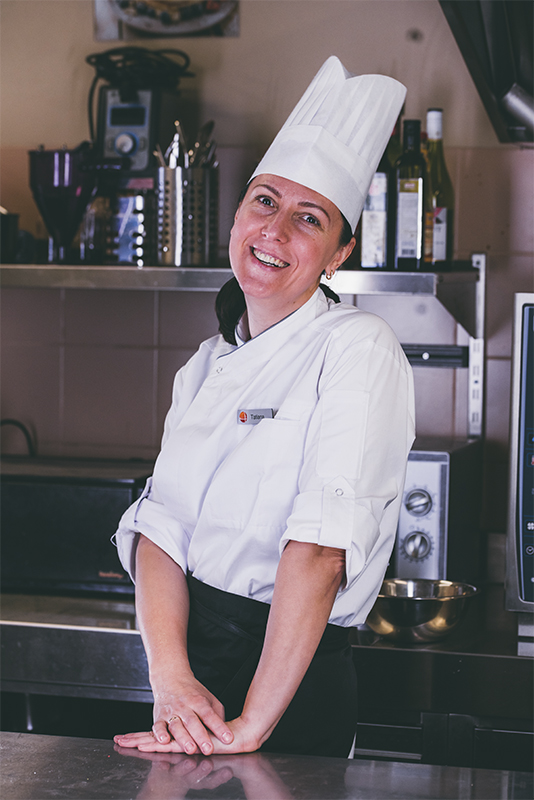
And my advice to students is to get an internship in hotels - not in a restaurant, but in a hotel. Hotels have volumes and a lot of varied work: there is restaurant service, banquets, and baking cakes for corporate orders. My opinion is that only in a hotel you can see all the technological processes and learn craftsmanship - this is an excellent school.
What achievements in your profession are you proud of?
I took part in the Marriott Black Box European Culinary Challenge, where I received gold in the qualifying round, and then represented Russian hotels in the finals in Brussels. Participated with the team in the Dubai World Hospitality Championships 2013 competition in Dubai, where we received bronze in the “Best Desserts” category.
What motivates you at work?
I am motivated by the support of my team and my family, they give me strength towards my goals and awareness in my professional activities. I think that my child, if asked, would be pleased to tell him that his father works as a chief engineer at a hotel, and his mother is a pastry chef at a hotel in the international chain AZIMUT Hotels. I really like my work, I try to develop as much as possible in my profession. What I do best is work with chocolate—decorating cakes, making candies, and developing the skill of creating sculptures.

Do you cook classics or experiment?
I love classics, but I also love experimenting with ingredients and textures. More often, together with our team, we adjust and modify recipes to suit ourselves and the tastes of our guests. We discuss, test, add something, remove something, even in classic recipes. This is how products appear on the menu of the Bakery and AZIMUT Hotel Olympic Moscow.
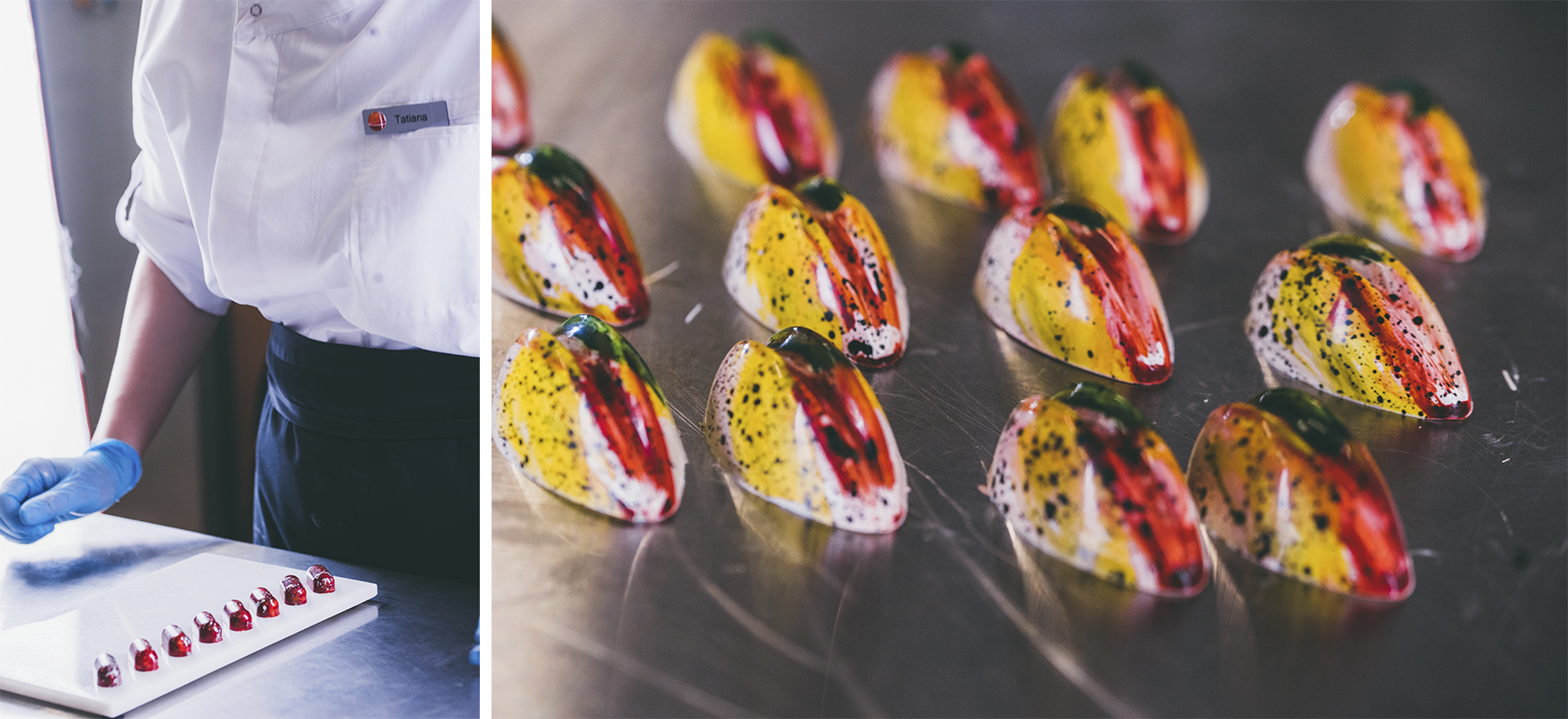
What can be called a classic in the confectionery business?
Now classics in cooking are three chocolates, tiramisu, bird's milk.
Is it difficult to come up with something new? What guides you when working on the menu?
It happens that it takes me several days to come up with a design: you see a dish, and you like it visually and tastefully, but when you take a photo, it’s not the same. The difficulties, rather, are not with the recipes, but with the design: to make it look beautiful. I believe that the presentation of the dish matters, although in Europe they hardly bother with this. And trends in vegetarianism and conscious consumption also affect the confectionery business: we are increasingly receiving such requests for banquets and buffets, and in the confectionery we are increasingly working only with low-calorie natural ingredients.

What is special about the confectionery sector in Azimuth?
The distinctive feature of AZIMUT Olympic cuisine, I think, is not only in the originality of the dishes, but also in the visual direction and design. I try to use shades of red and burgundy, that is, our corporate colors, the colors of the logo.
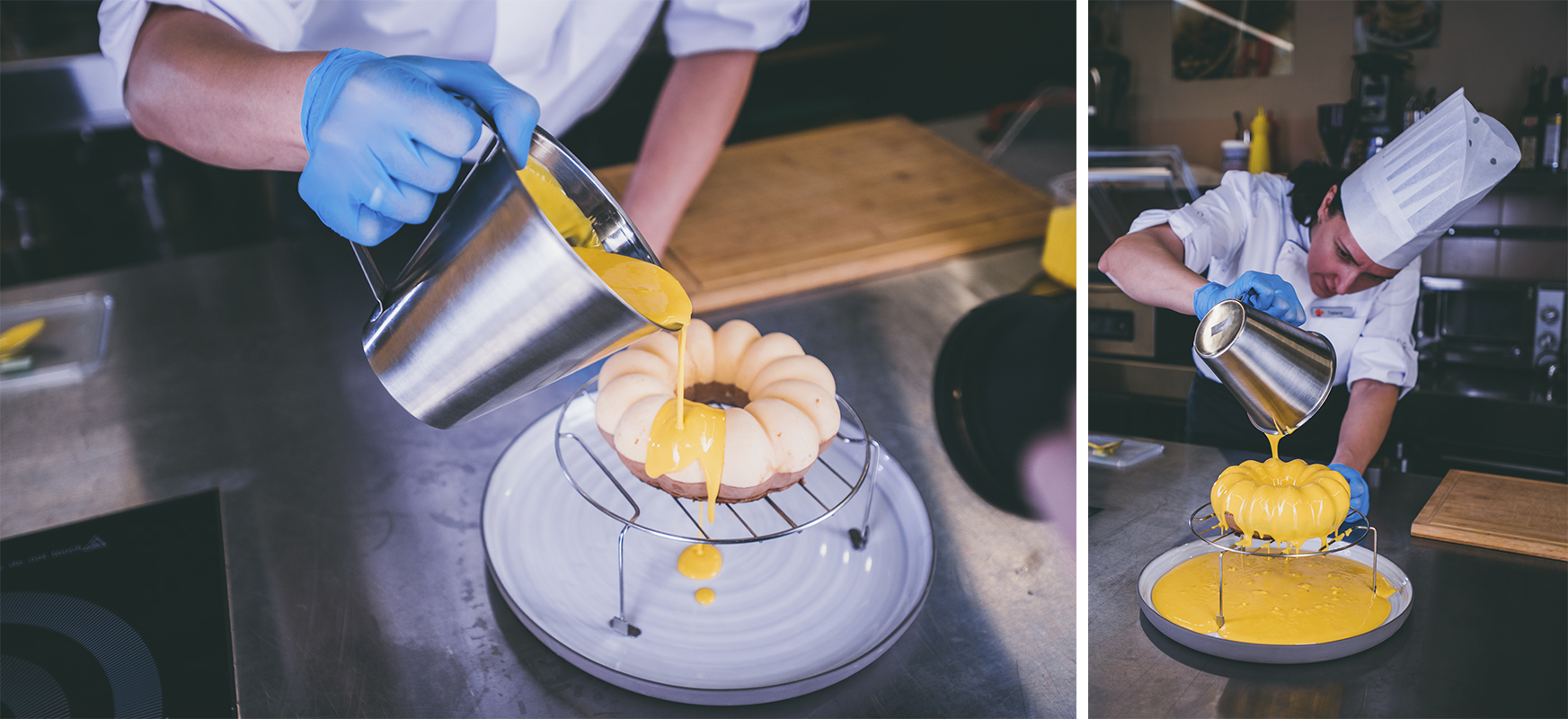
Can a guest's opinion influence your recipes?
We have a direction for making sweets to order. And of course, it can be difficult to work with requests and understand what exactly the guest wants and what is the best filling to choose. Sometimes you can recommend your vision of a recipe to the guest, offer an unusual taste or design of the dish, and sometimes it is better to do exactly what the guest asks.
Are there any trends in the confectionery business, and are you following them?
Some time ago there was a boomand 3D shapes. I recently ordered several to work through - they are very convenient to use for designing a set menu. I remember that we used to buy silicone from dentists for these purposes :) But in general, I like the classics.
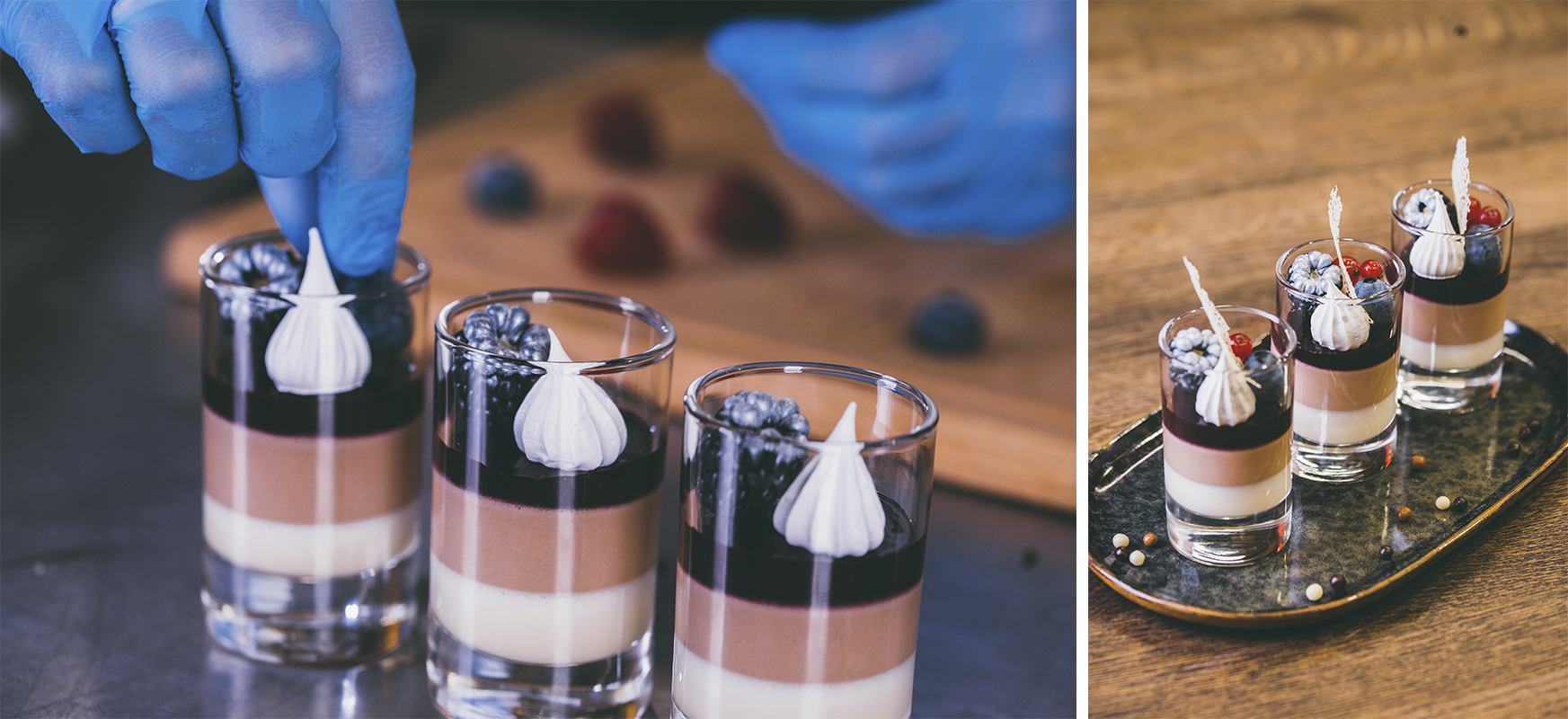
What equipment do you use most often in the kitchen?
If we are talking about large volumes and a buffet menu, then these are, of course, metal forms without a bottom - kara. We fill the 30x60 squares and then cut the finished product into squares and rectangles. This is always relevant and convenient for decoration. We also often use spatulas , knives, and mats.
What is the most challenging part of your job?
The most difficult thing is to please, to please the taste buds of guests when you cannot understand what they want. And over the phone, sometimes it’s difficult to understand what people want and expect, so I prefer to communicate in person.
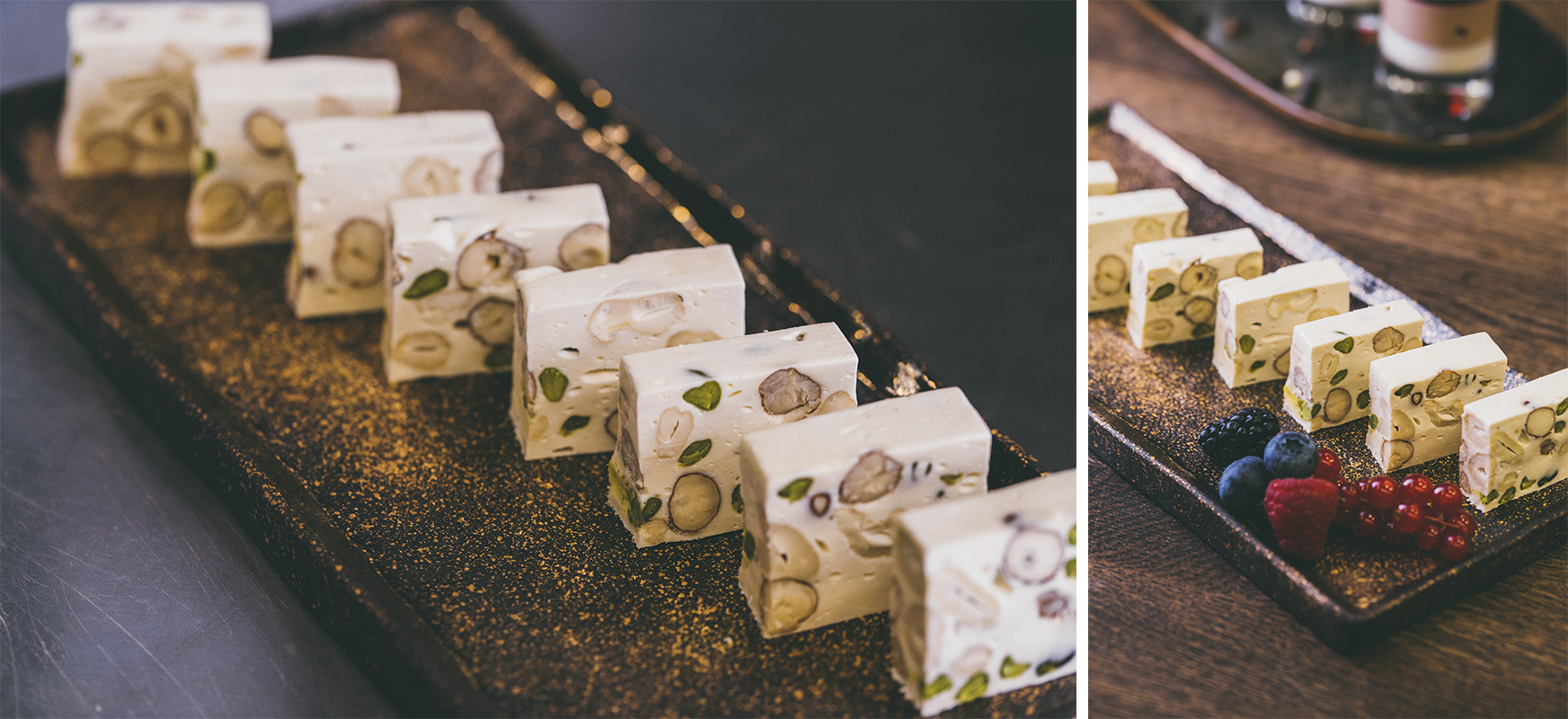
What is the most enjoyable thing about your work?
Reviews. Even if it’s bad, it’s to the point – for me it’s an incentive to move forward.
What do you need to do to become a professional in your field?
To become a professional, you need to work, study, and improve in your profession all your life. Don't stand still, walk, try, change the situation. The picture has changed - and you already look at some things differently.

Recipes from the pastry chef
1. Boxed sweets
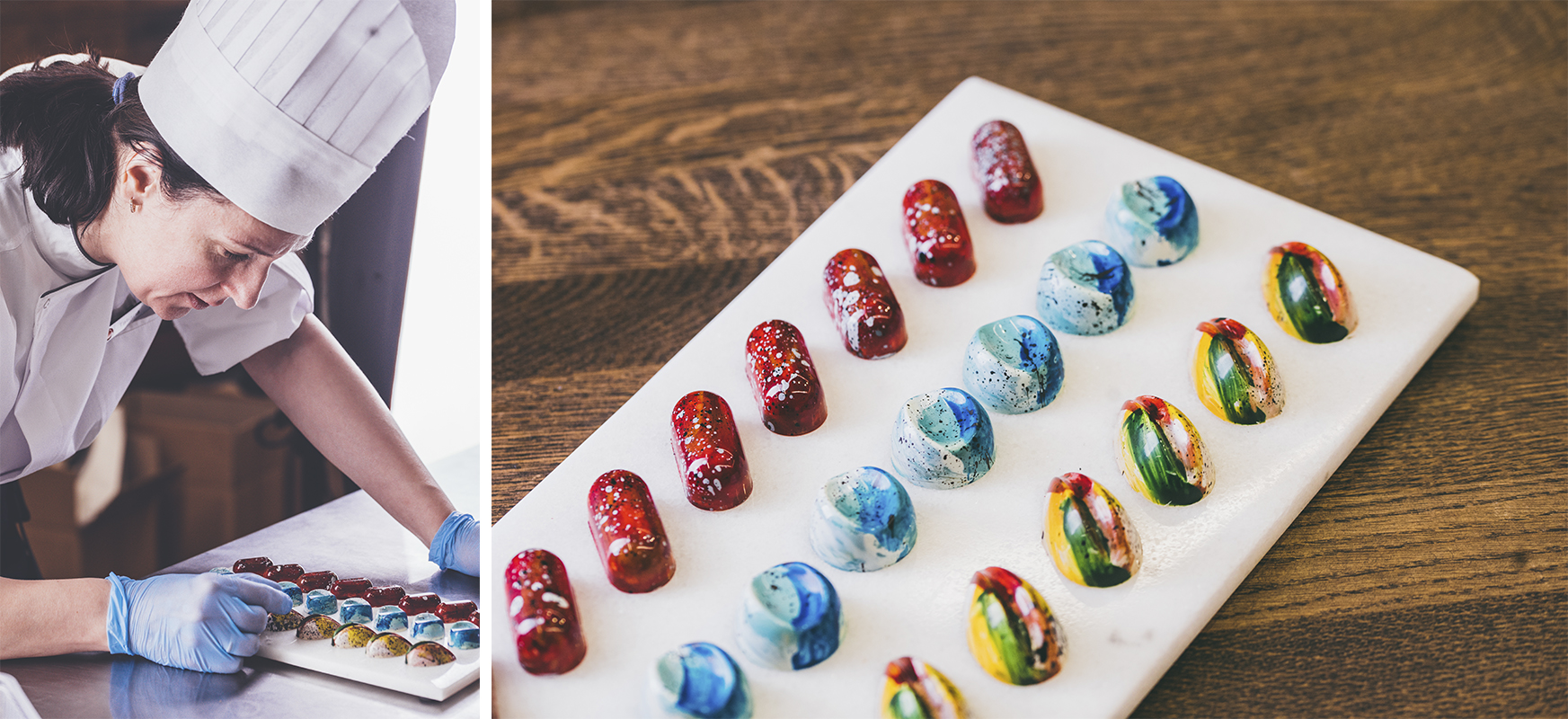
Orange ganache filling | 150ml cream 30 ml Cointreau 500 g white chocolate orange zest | Heat the cream with Cointreau and zest, then add melted chocolate (32C). Punch with an immersion blender. |
Cinnamon caramel filling | 280 ml cream 50 g sugar 3 g cinnamon 25 g glucose 100 g milk chocolate 150 g dark chocolate 50 g butter | From sugar and glucose, make dry caramel, then add warm cream and cinnamon, mix well. Two. Add two types of chocolate (32C) and room temperature butter. Stir and blend until emulsified. |
2. Summer lemon
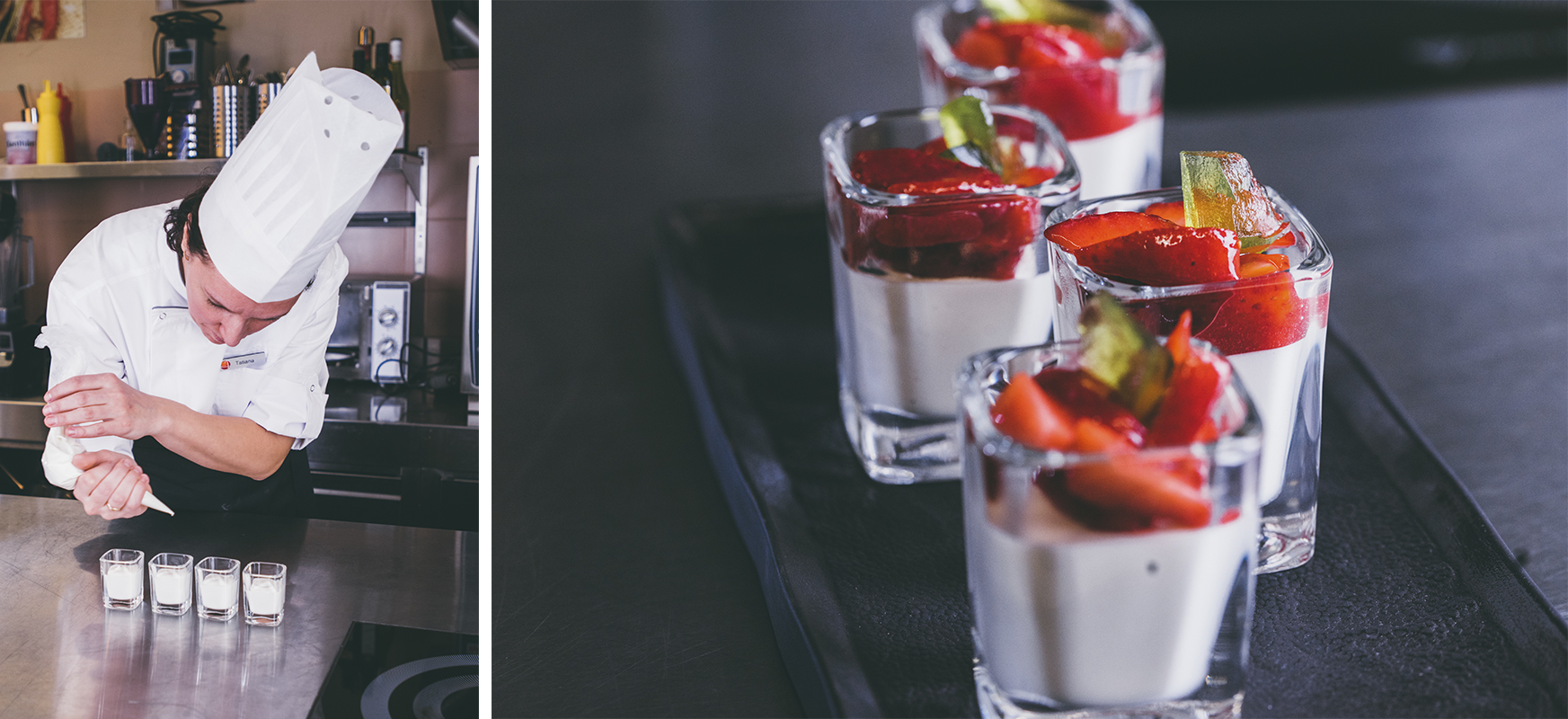
110 ml cream 50 ml lemon juice 110 g Italian meringue 9 g leaf gelatin | Dissolve gelatin (pre-soaked in cold water) in heated lemon juice. Then add Italian meringue and whipped cream. Stir until smooth and pour into shots (1/3 full). Let set in the cold. Decorate with fresh strawberries. |
3. Strawberry-ginger cheese
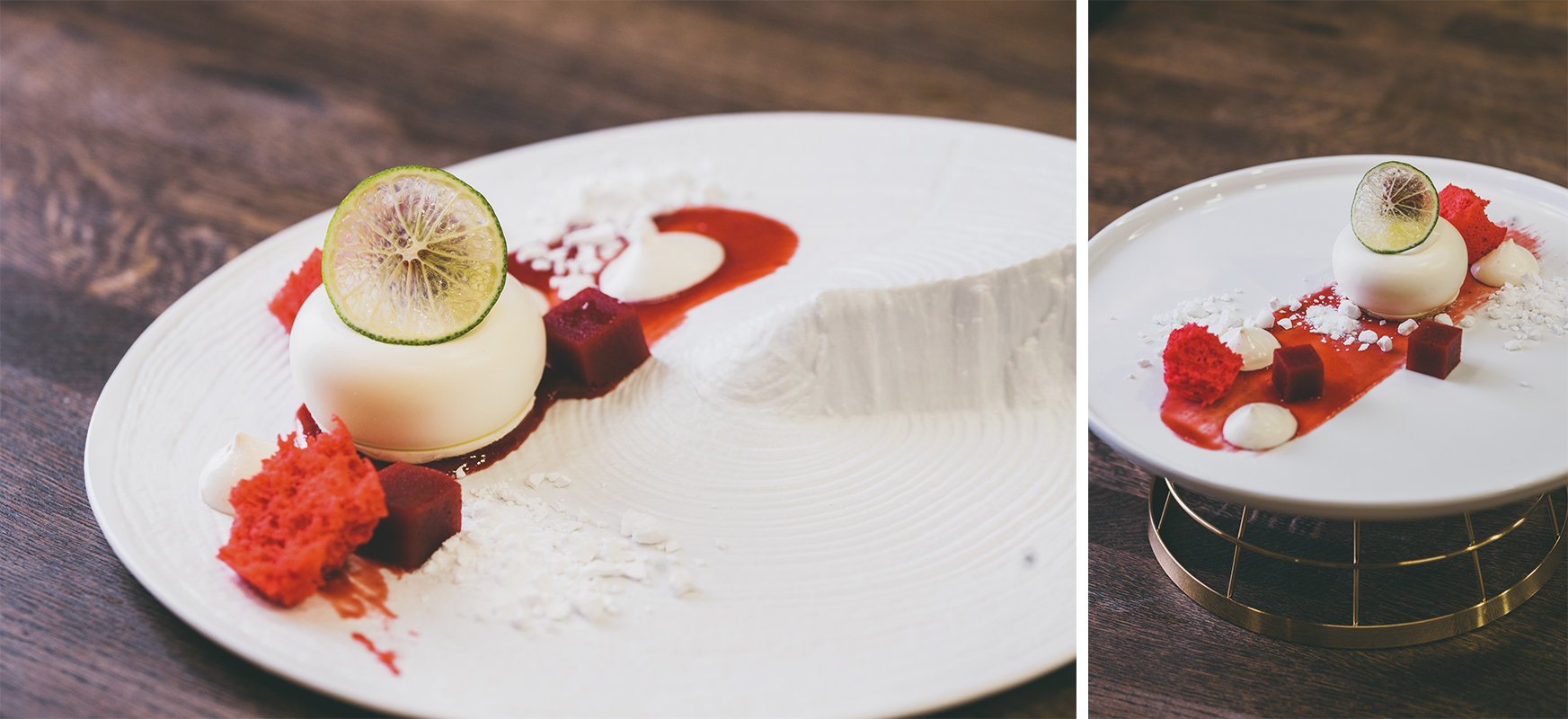
Mousse | 266 g curd cheese 97 g sugar 97 g Patiser cream 300 ml cream 48 ml lemon juice 10 g gelatin | Beat the cheese, sugar and cream well with a whisk. Then add warm juice with melted gelatin. Finally add whipped cream and mix well. |
Strawberry layer | 225 g frozen strawberries 65 g sugar 2 g dry ginger 5 g gelatin | Melt strawberries with sugar and ginger in a saucepan, simmer for a while and add gelatin at the end. Cool. |
Pour the mousse into a silicone mold, then a layer of white sponge roll, a strawberry layer and another sponge cake. To freeze. | ||
Strawberry jelly | 100 g strawberry puree 15 g sugar 3 g gelatin | Cool. |
Sponge | 15 ml protein 8 ml yolk 5 g almond powder 6 g flour 5 g sugar 3 g honey 1 g salt 1 g lemon zest | Microwave in plastic cups for 1/3 30 seconds. |
***
AZIMUT Hotels is an international hotel chain established in 2004. Today it includes 40 hotels in 31 cities in Russia, Germany, Austria and Israel. AZIMUT Hotels manages hotels that are owned, based on management agreements, franchises and long-term leases. Chairman of the Board of Directors – Alexander Klyachin.
AZIMUT Hotels in Russia (Astrakhan, Vladivostok, Voronezh, Kemerovo, Kostroma, Kyzyl, Mirny, Moscow, Murmansk, Nalchik, Nebug, Nizhny Novgorod, Novosibirsk, Penza, Pereslavl, Rostov Veliky, Samara, St. Petersburg, Sochi, Suzdal, Uglich, Ufa, Yakutsk, Yaroslavl); in Germany (Berlin, Dresden, Cologne, Munich, Nuremberg, Erding); in Austria (Vienna); in Israel (Netanya).
















































/https%3A%2F%2Fcomplexbar.com%2Fimages%2Fblog%2F58%2F4-4.jpeg)
/https%3A%2F%2Fcomplexbar.com%2Fimages%2Fblog%2F246%2Fsirop_scale_2400.jpeg)
/https%3A%2F%2Fcomplexbar.com%2Fimages%2Fblog%2F246%2Fkofe-vostochniy.jpg)
/https%3A%2F%2Fcomplexbar.com%2Fimages%2Fblog%2F245%2Fpexels-jason-villanueva-851555.jpg)
/https%3A%2F%2Fcomplexbar.com%2Fimages%2Fblog%2F246%2F2024-04-09_17.22.54.jpg)
/https%3A%2F%2Fcomplexbar.com%2Fimages%2Fblog%2F246%2F2024-04-09_17.22.47.jpg)
/https%3A%2F%2Fcomplexbar.com%2Fimages%2Fblog%2F246%2FCODE_anons_foamydrops_752%D1%85480_eng.jpg)
/https%3A%2F%2Fcomplexbar.com%2Fimages%2Fblog%2F246%2FAlina_752%D1%85480_eng.jpg)
/https%3A%2F%2Fcomplexbar.com%2Fimages%2Fblog%2F246%2F2024-04-09_17.23.22.jpg)
/https%3A%2F%2Fcomplexbar.com%2Fimages%2Fblog%2F246%2F2024-04-09_17.23.28.jpg)
/https%3A%2F%2Fcomplexbar.com%2Fimages%2Fblog%2F246%2F2024-04-09_17.23.35.jpg)
/https%3A%2F%2Fcomplexbar.com%2Fimages%2Fblog%2F246%2Fdrinksome_752%D1%85480_eng.jpg)
/https%3A%2F%2Fcomplexbar.com%2Fimages%2Fblog%2F246%2Fnude_752%D1%85480_eng.jpg)
/https%3A%2F%2Fcomplexbar.com%2Fimages%2Fblog%2F246%2F752%D1%85480_eng__1_.jpg)
/https%3A%2F%2Fcomplexbar.com%2Fimages%2Fblog%2F246%2F752%D1%85480_eng.jpg)
/https%3A%2F%2Fcomplexbar.com%2Fimages%2Fblog%2F246%2FStudioRaw_752%D1%85480_eng.jpg)
/https%3A%2F%2Fcomplexbar.com%2Fimages%2Fblog%2F246%2FDoppio_tea_752%D1%85480_eng.jpg)
/https%3A%2F%2Fcomplexbar.com%2Fimages%2Fblog%2F246%2FTognana_Stars_Stripes_752%D1%85480_eng.jpg)
/https%3A%2F%2Fcomplexbar.com%2Fimages%2Fblog%2F246%2FRona_752%D1%85480_eng.jpg)
/https%3A%2F%2Fcomplexbar.com%2Fimages%2Fblog%2F246%2FDoppio_vending_752%D1%85480_eng.jpg)
/https%3A%2F%2Fcomplexbar.com%2Fimages%2Fblog%2F246%2FEssence_sukhie_smesi_752%D1%85480_eng.jpg)
/https%3A%2F%2Fcomplexbar.com%2Fimages%2Fblog%2F246%2FODK_sukhie_smesi752%D1%85480_eng.jpg)
/https%3A%2F%2Fcomplexbar.com%2Fimages%2Fblog%2F246%2Funiforma-barmena.jpg)
/https%3A%2F%2Fcomplexbar.com%2Fimages%2Fblog%2F246%2Fkak-nanyat-barmena.jpg)
/https%3A%2F%2Fcomplexbar.com%2Fimages%2Fblog%2F246%2Fsirop_scale_2400.jpeg)
/https%3A%2F%2Fcomplexbar.com%2Fimages%2Fblog%2F246%2FPeugeot_Anons_Paris_U%27Select_Line_Daman_752%D1%85480_eng.jpg)
/https%3A%2F%2Fcomplexbar.com%2Fimages%2Fblog%2F246%2Fkofe-vostochniy.jpg)
/https%3A%2F%2Fcomplexbar.com%2Fimages%2Fblog%2F246%2FMadler.jpg)
/https%3A%2F%2Fcomplexbar.com%2Fimages%2Fblog%2F246%2Fprofbartender_glavn.jpeg)